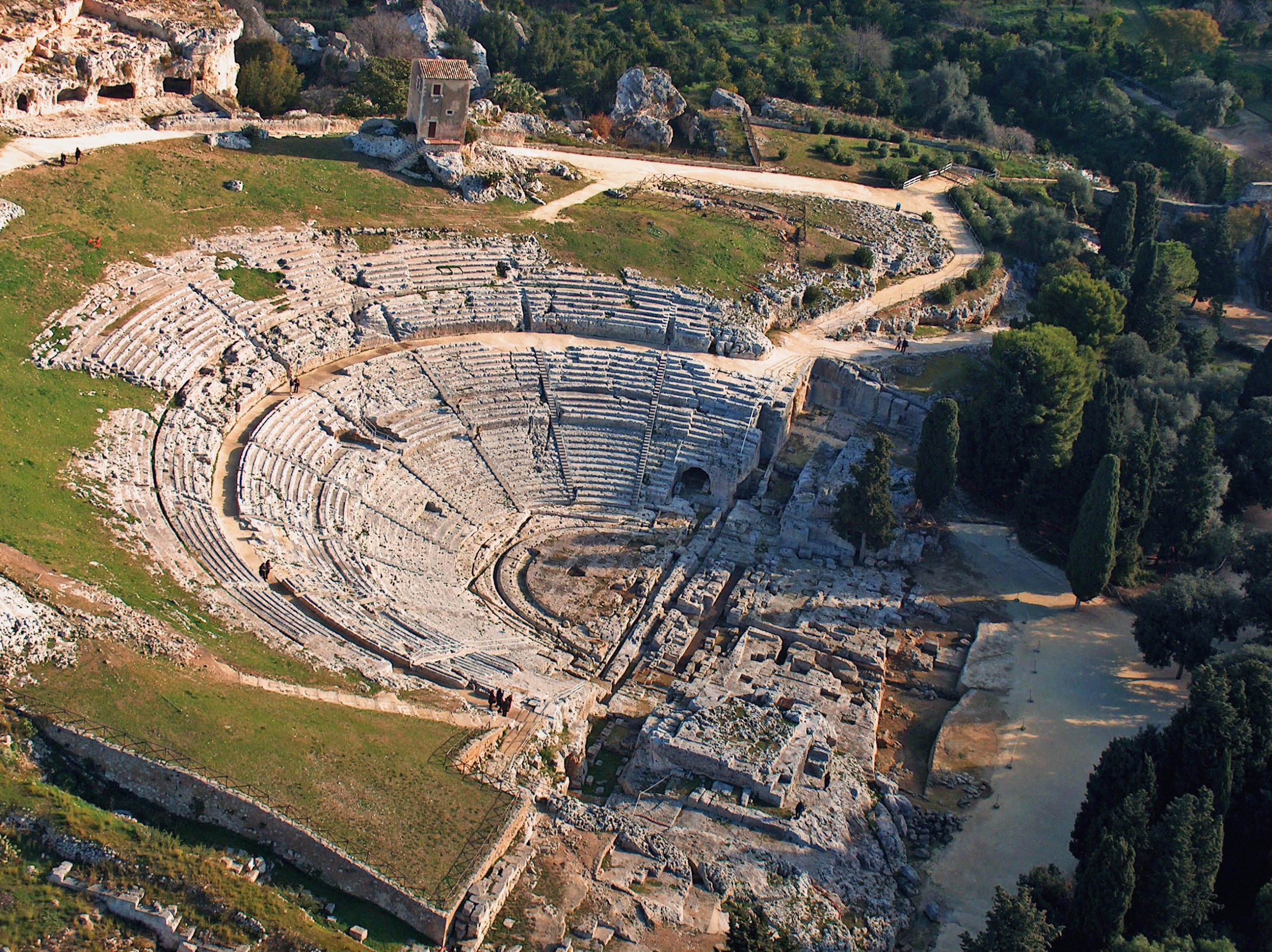Archimedes Square
Archimedes Square, dedicated to one of the most illustrious sons of Syracuse, is the second most important square of Ortigia, thanks to its central position in the historic center. In Greek times, although it was not a square, it was one of the main crossroads formed by the decumanus major (via Dione-via Roma) and the decumanus minor (via Maestranza-via Amalfitania). Topographically it represents the main crossroads of important streets and the center on which overlook some of the main buildings of the island.
The square, trapezoidal in shape, has assumed its current appearance in recent times between 1872 and 1878: with the demolition of the church of St. Andrew and later that of St. James began a series of construction operations deemed necessary for the opening of a new town square. In the empty area is inserted the fountain of Diana, a sculptural work in reinforced concrete, made by Giulio Moschetti in 1906. The position of the statue, depicting the goddess facing Via Maestranza, still reflects the ancient importance of the street as an area of access to the square. Between 1934 and 1936, in the middle of the Fascist era, the most important and decisive demolition of the medieval urban fabric was carried out to open the new Via del Littorio (nowadays Corso Matteotti).
At the same time, the Old Barracks were demolished, allowing the Temple of Apollo to be revealed. The buildings overlooking the square summarize the entirety of the island’s history, from the Middle Ages to the present day. Coming from Corso Matteotti, starting from the left and proceeding clockwise, we find the Palazzo del Banco di Sicilia, built in 1928 on a project by Salvatore Caronia, characterized by a portal framed by semi ashlar columns and a second order marked by Ionic pilasters.
Next to Via Dione is Palazzo Pupillo, built in the second half of the 18th century in late Baroque style, with a slightly convex façade, irregular in relation to the road axis Via Dione The facade of the palace presents five arched portals surmounted by five balconies, the central one surmounted by a broken tympanum, while the other four possess semicircular and triangular tympanums. Above there is a last row of five balconies, the central one surmounted by a semicircular tympanum, while the others feature a shelf with geometric bas-reliefs. The palace is crowned by a beautiful crenellated entablature.
Next to Palazzo Pupillo is the Palazzo dell’Ex Cassa Centrale di Risparmio Vittorio Emanuele, built in the area occupied until the 1950s by Palazzo Corvaia and Palazzo Zumbo. The first, the work of Giovanni Vermexio in 1628, was irreparably damaged by the Allied air raid on the night of February 15, 1942. The second, which incorporated fifteenth-century architectural structures, was demolished in the autumn of 1957 to make way for the new building designed by the architect Gaetano Rapisardi and the technical advice of the architect Salvatore Caronia. The colonnaded solution of the cantonal building is based on the model of the destroyed Vermex building.
The intersection between via Maestranza e via Roma
is characterized by the angular prospect of Palazzo Interlandi Pizzuti, built in 1910 following the chamfering of the corner that originally lapped the area of the square and that, due to the difficult circulation of cars, had suffered considerable damage. It is a baroque palace built in the eighteenth century and later enriched with elements in Art Nouveau style. The palace is divided into two facades, one in Archimedes Square and the other in Via Roma.
The two facades are characterized by a series of arches with keystone Art Nouveau with geometric decorations, in the middle of which there are the entrance doors.
Then follows the Palazzo Gargallo, built in the seventeenth century at the behest of the powerful family Gargallo (one of the most powerful of Siracusa
along with the Bonanno, Landolina, Arezzo della Targia, Interlandi and Montalto). This palace was seriously damaged by the earthquake of 1693 and restored for the first time in the early ‘700 and a second time in the last half of the ‘800 to assume its current appearance, with the lavish stucco decoration. The valuable frescoes on the vaults by Ernesto Bellandi date back to that period. Of the original seventeenth-century structure remain the stables, with imposing vaults implanted on sturdy pillars. Elegant pillars and crenellated trabeations frame the external walls of the palace. Tommaso Gargallo was born in this palace on 25 September 1760.
Next to Palazzo Gargallo is Palazzo Lanza Bucceri, the oldest of the remaining buildings standing at Archimedes Square, formerly also known as ‘Palazzo Platamone’. It is a palace built in the last years of 1300 but has renaissance renovations dating back to 1400, and Catalans dating back to 1500-1600. The facade, rather sober, is characterized by a simple rectangular portal and mullioned windows (some of which are conspicuously ruined). The Palace also has beautiful sculptural decorations. It still preserves the coats of arms on the capitals of the columns of clear Catalan setting, with a mullioned window that the wind and rain have embroidered.
Located between the corner of Archimedes Square with via Amalfitania and adjacent to the Palace of the Bank of Italy, is the Palazzo Ex Casa Tarantello, both buildings are connected to each other since the nineteenth century and with the courtyard in common.
The branch of the Bank of Italy occupies the other half of the nineteenth century building that was formerly identified with the name ‘House of the Clock’, as the City Hall in 1882 had placed on the main facade a clock similar to what there was in the bell tower of the church of St. Andrew the Apostle. The building, imposing and austere, dates back to the fifteenth century, from the large wrought iron gate you can see the exposed Catalan staircase with a lion in a heraldic position and the mullioned window marked by a fine column. The current facade features an entrance arch closed by a beautiful wrought iron grille, surmounted by a beautiful stone balcony with a triple lancet window (a Renaissance style architectural element remained unchanged).
Location: Piazza Archimede – Isola di Ortigia – Siracusa


